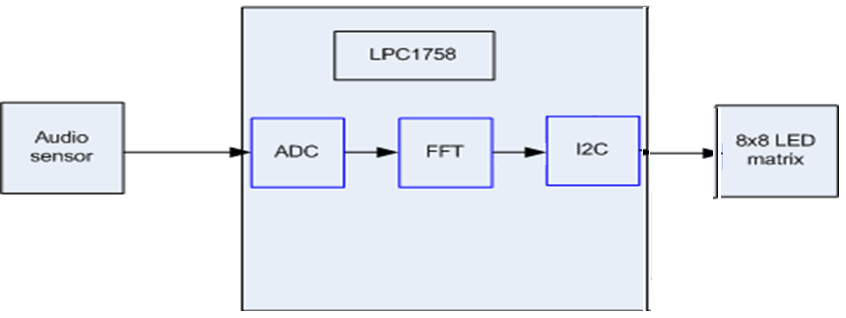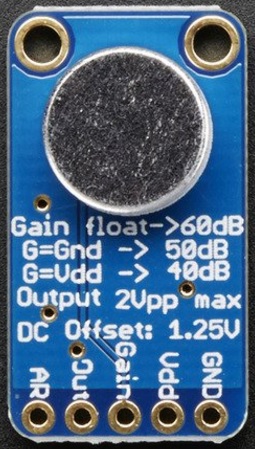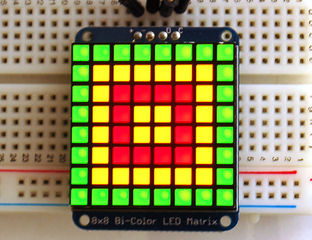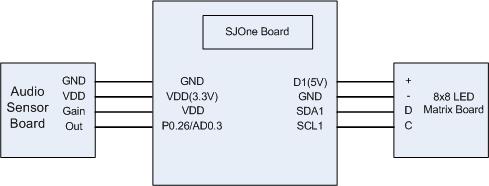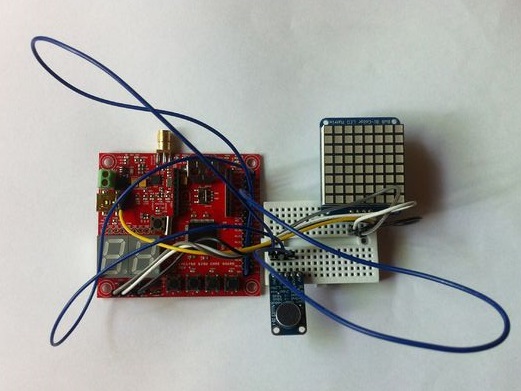S16: Mars 1
Contents
Grading Criteria
- How well is Software & Hardware Design described?
- How well can this report be used to reproduce this project?
- Code Quality
- Overall Report Quality:
- Software Block Diagrams
- Hardware Block Diagrams
- Schematic Quality
- Quality of technical challenges and solutions adopted.
Project Title
Spread Spectrum Audio Visualizer
Abstract
The main goal is to design a LED display system to visualize audio frequency spectrum. The system we designed is capable of displaying audio frequencies up to 4 kHz as we have taken 8*8 LED Matrix to display.The audio is sampled through an audio amplifier with 50dB. The signals will be converted by integrated ADC module in the LPC1578 micro controller. The FFT algorithm is implemented to convert the value from time domain to frequency domain.Extracted frequency samples are manipulated to get power spectrum and will be given to LED matrix display through I2C interface. The LED matrix display will light up horizontal(row) and vertical(column) LEDs depending on the spectral component present in it.LED Matrix X-axis (rows) correspond to frequency and Y-axis (columns) correspond to power of that frequency, taken as the complex square root of the real and imaginary parts.
Objectives & Introduction
The main objective of the project is to convert audio analog signal from time domain to frequency domain and display the frequency and amplitude using LED matrix.
- 1. The control unit is using LPC1578 SJOne board which perform the Fast Fourier Transform(FFT). It takes input from audio module and uses ADC to convert to digital signals as input of FFT module, it uses I2C bus to write LED matrix board to display.
- 2. The audio input module is Adafruit Electric Microphone Amplifier - MAX9814 with Auto Gain Control; If takes sound/audio as input and filter the noise and pass the analog signal to SJOne board.
- 3. The 8x8 LED matrix is Adafruit Bicolor LED Square Pixel Matrix with I2C Backpack.There is I2C slave chip on board so SJOne board can write the registers to light up the LED to indicate frequency and amplitude.
Team Members & Responsibilities
- Jaswanth Bhimanapalli
- Fast Fourier Transforms(FFT) + I2C + Debugging ADC,LED Matrix issues +Video demo preparation +Testing
- Sucharitha Sirigireddy
- Fast Fourier Transforms(FFT) + I2C + Debugging ADC,LED Matrix issues +Video demo preparation +Testing + making PPT + writing report and proposal review
- Tianran Chen
- LED interfacing + making PPT
- Wei Liu
- ADC interfacing + Wikipedia update + Project proposal
Schedule
Show a simple table or figures that show your scheduled as planned before you started working on the project. Then in another table column, write down the actual schedule so that readers can see the planned vs. actual goals. The point of the schedule is for readers to assess how to pace themselves if they are doing a similar project.
| Week# | Start Date | End Date | Task | Status | Actual Completion Date |
|---|---|---|---|---|---|
| 1 | 03/07/2016 | 03/13/2016 | Submitted project proposal | Completed | 03/13/2016 |
| 2 | 03/14/2016 | 03/20/2016 | Research on system block diagram | Completed | 03/20/2016 |
| 3 | 03/21/2016 | 03/27/2016 | Study and Design led display of audio spectrum | Completed | 03/27/2016 |
| 4 | 03/28/2016 | 04/03/2016 | Parts Purchase | Completed | 04/06/2016 |
| 5 | 04/04/2016 | 04/10/2016 | Develop program for ADC driver | Completed | 04/18/2016 |
| 6 | 04/11/2016 | 04/17/2016 | Create task for buffering audio spectrum | Completed | 04/18/2016 |
| 7 | 04/18/2016 | 04/24/2016 | Finish coding and simulate software code; | Completed | 04/28/2016 |
| 8 | 04/25/2016 | 05/01/2016 | Initial bring up hardware board | Completed | 05/01/2016 |
| 9 | 05/02/2016 | 05/08/2016 | Initial Testing and debug and fix all hardware issues | Completed | 05/12/2016 |
| 10 | 05/09/2016 | 05/15/2016 | Final Testing and debug and fix all software issues | Completed | 05/17/2016 |
| 11 | 05/16/2016 | 05/22/2016 | Final Wiki report, Powerpoint, recording video | Completed | 05/22/2016 |
| 12 | 05/24/2016 | 05/24/2016 | Final Demo Day | TBD |
Parts List & Cost
| Component Name | Quantity | Cost per Item | Total Cost |
|---|---|---|---|
| Audio Amplifier Board | 1 | $7.95 | $7.95 |
| LPC1758 SJOne Board | 1 | $80 | $80 |
| LED Matrix (8 X 8) | 1 | $15.95 | $15.95 |
| Wires | 6 | $0.1 | $0.6 |
| Total | $94.5 |
Design & Implementation
The design section can go over your hardware and software design. Organize this section using sub-sections that go over your design and implementation.
Hardware Design
The hardware system is composed of audio board with sensor and filters, SJOne board based on LPC1758, LED matrix board. The block diagram is shown in below.
1. Audio Sensor Board:
The audio board is Adafruit AGC Electret Microphone Amplifier - MAX9814 as shown below:
The major parameters of the audio sensor board used in this project are:
- Supply Voltage: 3.3V @ 3mA current
- Output: 2Vpp on 1.25V bias
- Frequency Response: 20Hz - 20 KHz
- Programmable Attack and Release Ratio
- Automatic gain:40dB
2. SJOne Board:
The SJOne board is using NXP LPC1758 microcontroller. The top view of the board is shown below:
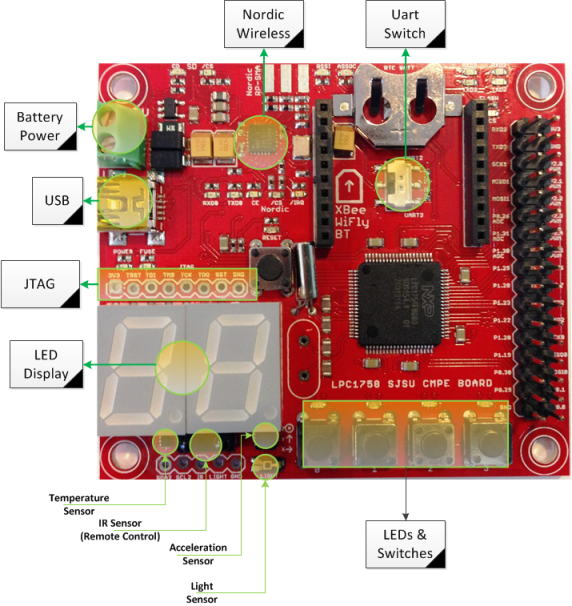
3. 8x8 LED Matrix Board: The led Matrix board is Adafruit Bicolor LED Square Pixel Matrix with I2C Backpack
Hardware Interface
As shown in the block diagram, the system is composed with 3 boards.
The wiring of the system is shown in below Figure.
For the audio sensor board,there are 4 pins connected to SJOne board:
- 1. GND connects to the X2 pin16(GND) in SJOne board;
- 2. VDD connects to the X2 pin17(VDD) in SJOne board.
- 3. Leave the Gain pin open to have gain as 60dB.
- 4. Connect the OUT pin to X1 pin 12(AD0.3) in SJOne board.
For the 8x8 LED matrix board, there are only 3 pins connected to SJOne board.Thanks to the “smarts” of the LED matrix backpack, this whole project requires fewer than a dozen parallel connections total:
- 1. Connect the LED matrix + pin to the SJOne Diode D1 cathord side as 5V to power up the LED board.
- 2. Connect the LED matrix – pin to X1 pin 1(GND) in SJOne board.
- 3. Connect the matrix backpack D (data) to X2 Pin 1(SDA1) in SJOne board and C (clock) pin to X2 pin 2(SCL1) in SJOne board, respectively.
Inside the SJOne board, ADC(Port 0.26)is used to sample the analog signals from audio sensor board. The converted digital signals will be 12 bits and they are passed to FFT module, after the FFT is calculated, the new values will be decoded by ARM controller and the controller will use I2C to write the registers in the LED matrix to light up the LEDs.
Software Design
Show your software design. For example, if you are designing an MP3 Player, show the tasks that you are using, and what they are doing at a high level. Do not show the details of the code. For example, do not show exact code, but you may show psuedocode and fragments of code. Keep in mind that you are showing DESIGN of your software, not the inner workings of it.
Implementation
This section includes implementation, but again, not the details, just the high level. For example, you can list the steps it takes to communicate over a sensor, or the steps needed to write a page of memory onto SPI Flash. You can include sub-sections for each of your component implementation.
Testing & Technical Challenges
Describe the challenges of your project. What advise would you give yourself or someone else if your project can be started from scratch again? Make a smooth transition to testing section and described what it took to test your project.
Include sub-sections that list out a problem and solution, such as:
My Issue #1
Discuss the issue and resolution.
Conclusion
Conclude your project here. You can recap your testing and problems. You should address the "so what" part here to indicate what you ultimately learnt from this project. How has this project increased your knowledge?
Project Video
Upload a video of your project and post the link here.
Project Source Code
References
Acknowledgement
Any acknowledgement that you may wish to provide can be included here.
References Used
List any references used in project.
https://en.wikipedia.org/wiki/Fast_Fourier_transform
https://learn.adafruit.com/fft-fun-with-fourier-transforms/spectrum-analyzer
https://en.wikipedia.org/wiki/Spectrum_analyzer
Appendix
You can list the references you used.
